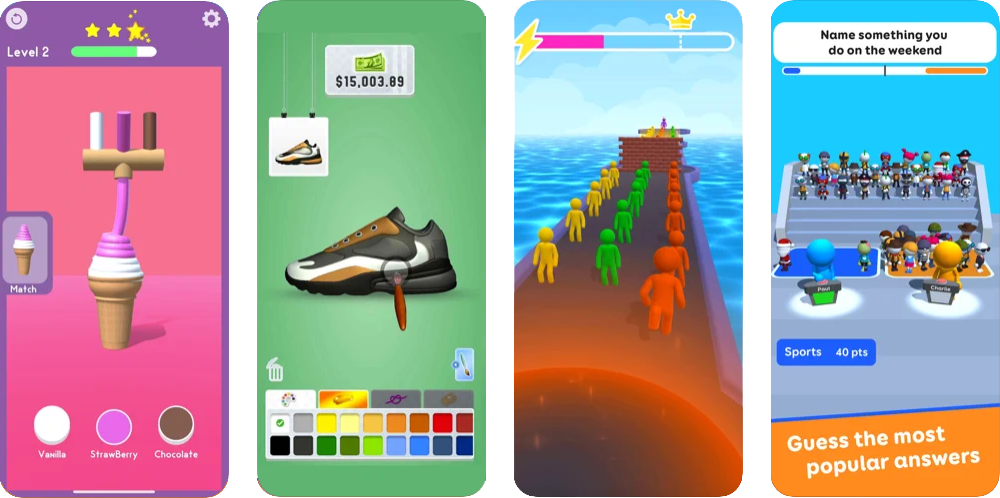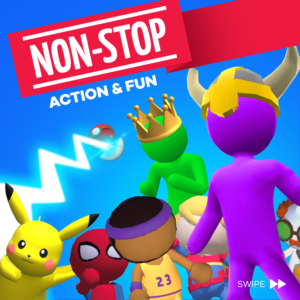
Jonathan Comisi – Feb 17, 2021
Hypercasual games are designed to go beyond simply being casual. Every step of development is about integrating frictionless gameplay and finding new ways to combine addictive gameplay with eye-catching art.
Everything must be simple and fun.
That may seem vague to some, but it’s the only way to ensure the best results with such a large audience of anybody with a phone. In today’s world, that means hypercasuals are aiming for the entire world. Everybody everywhere should be able to play your game at any time.

Game Design Done Right
If you look at the hits from TapNation, you’ll notice they all share the key components that go into making a successful hypercasual game.
- Short Sessions – A big part of keeping hypercasual games more than just casual is designing around short sessions. The ideal length of play should pass the coffee test, making sure someone can play a round in the time it takes to order a cup of coffee.
- Easy to Pick Up – Keeping things casual also means there should be nothing new users need to learn. Everyone from the age of 5 to 55 and beyond should be able to play using nothing but their instincts.
- Non-stop Action – Hypercasuals are not meant to be slow burns or thought provoking essays. They are popcorn superhero movies and amusement park rides with flashing lights and colorful explosions.
- Non-stop Fun – There should never be any downside or risk involved in hypercasual gameplay. Let the player just have fun by building around one-handed actions and overpowering their character. It’s about letting the player relax and enjoy every millisecond of the session.
- Gameplay, Gameplay, Gameplay – Hypercasual hits find that special something that people intuitively want to play. A satisfying swipe or a rewarding animation is all it takes to have new users spending a few moments in your game. The gameplay needs to be something simple but effective.
Game Design Done Wrong
The other side of the game design puzzle is making sure you don’t make any of the common mistakes.
- Avoid long sessions
- Avoid steep learning curves
- Avoid slow burns
- Avoid long tutorials
- Avoid creating anything without a clear gameplay mechanic in mind
Most of these can be easily summarized as never adding complexity. To paint a better picture, take a look at a couple of the most important game design concepts that should be avoided at all cost if you are making a hypercasual game.
Avoid Stressful Gameplay
A fun game doesn’t need difficult enemies or fast-paced reflex oriented mechanics. Puzzles don’t need to be a knot of riddles and a short drive doesn’t need to be a stiff competition.
Hypercasuals are a warm welcome into a relaxing break from the stress of a busy day.
The entire game session should be a joyful experience that never feels bad and can be played anywhere by anyone at any time.
Avoid Complex Gameplay
It’s easy to confuse gameplay depth with complexity and it’s easy to confuse a lack of depth with boring gameplay. The balance between these ideas is why it’s so important to quickly iterate on ideas and find what actually works without adding needlessly complex controls or metagame.
A good hypercasual gets straight to the point and is smart about how you play.
It’s not complex and doesn’t spend time on extra features. The game is instantly understood and has people playing the moment it loads. In some ways that makes the ideal hypercasual game the perfect game for everyone but hardcore gamers.

Simple and Fun
There’s a bit of a paradox attached to it being so difficult to create a game that’s so easy to play. Throwing out complex controls and any stereotypical gaming environment means designing around the essential ideas of what makes something fun to play.
If you ever need to ask if a new mechanic is too complex or an idea too hard to understand, that should be a sign that the design is heading in the wrong direction.
Remember: keep it simple, keep it satisfying, and keep it fun.




